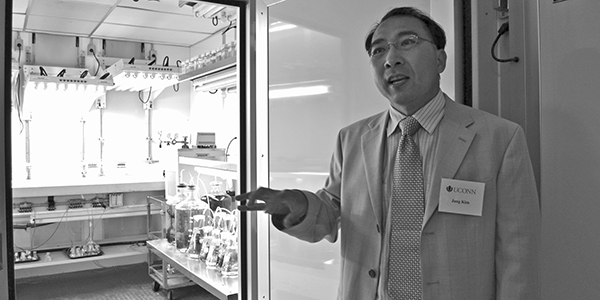Seaweed spurts new business growth

The University of Connecticut is bridging the gap between environmental research and business with its seaweed revenue project, potentially worth $108 million annually.
University research shows that seaweed can easily be grown in the Long Island Sound and its byproducts have the potential to create a very profitable business opportunity. As a bonus, the crop naturally clears up water pollution.
“This project is a concrete example of how UConn is taking the lead in creating real, sustainable jobs,” said professor Charles Yarish, the project”™s lead researcher. Yarish and a team of more than 10 students and faculty members presented their findings and plans at the Stamford Learning Accelerator in mid-August. The school is in the process of writing legislation and developing a business plan to launch its own farm.
When seaweed cell walls are broken down, the crop”™s lipids, sugars and proteins can be used to create fertilizer, biodiesel, biofuel, biogas and electricity. Measuring the best profitability streams, MBA students said the most viable retail products included agar, animal feed, fertilizers and sea vegetables, with margins ranging from 20 percent to nearly twenty-fold. In the future, the seaweed could also make butanol and medications.
Thimble Island Oyster Co. in Branford is the first to set up a rotational seaweed and shellfish farming system in the Long Island Sound. After owner Brendan Smith lost a significant portion of his business in Tropical Storm Irene, Smith said he was interested in developing a more sustainable ocean farm. Partnering with Yarish, they”™ve begun to pioneer 3-D farming where the growth and harvest cycles last all year.
“This is the new normal,” Smith said. “It”™s an ocean farmer”™s dream.”
Kelp is grown and harvested in the spring and winter; red seaweed is grown and harvested in the summer; mussels are grown and harvested in the fall and spring; and oysters, scallops and clams are raised year round.
Seaweed is the third-best performing yield after corn and rice, said Marcello Graziano, a Ph.D. student. Analyzing the sound for medium- to high-suitability areas for seaweed farming, Graziano estimated that the sound could conservatively produce 69,400 tons per year, at a value of $1,560 per ton.
But besides its retail value, the seaweed is also worth its weight in nitrogen credits from the Connecticut Department of Energy and Environmental Protection. Seaweed can be a powerful way to clean up water pollution, such as excess nitrogen, phosphorous and carbon.
As a way to reduce nitrogen in the sound, the state already offers credits of about $4.60 per pound of removed nitrogen. The amount of nitrogen seaweed removes is the equivalent of 5 percent of its weight, meaning the crop could be worth $32 million annually in nitrogen credits as well.
“UConn is leveraging its faculty, students, its significant research and other resources to help grow businesses in Connecticut and create jobs,” said Brian Brady, director of the Stamford Learning Accelerator. The project will “help spin off business and grow existing businesses.”